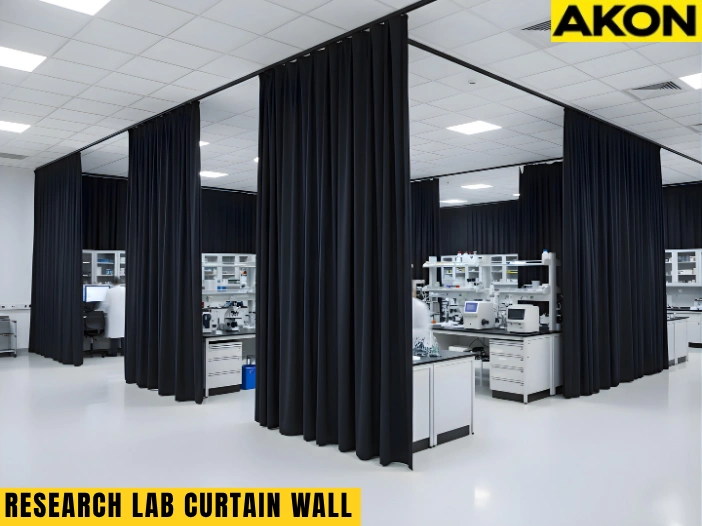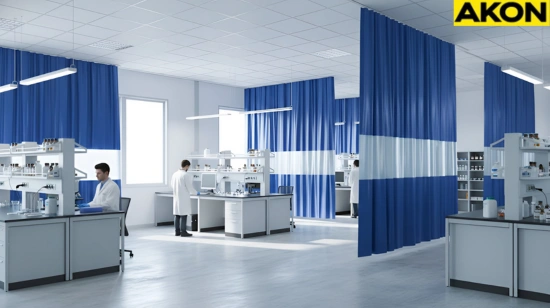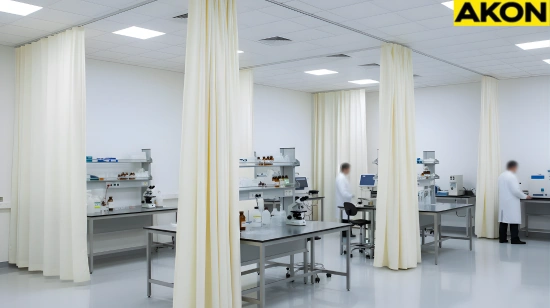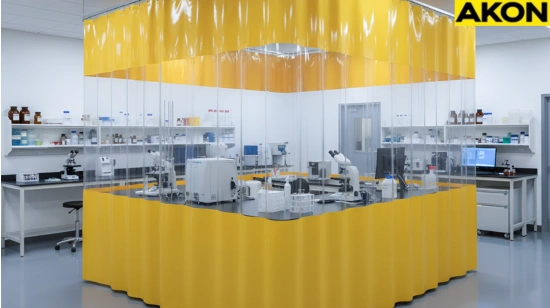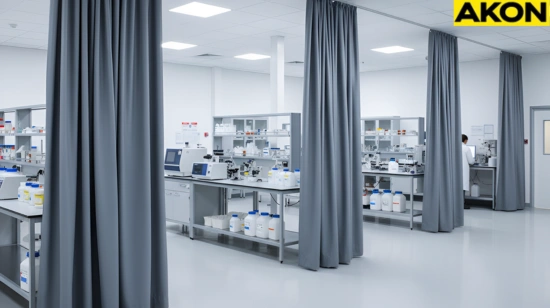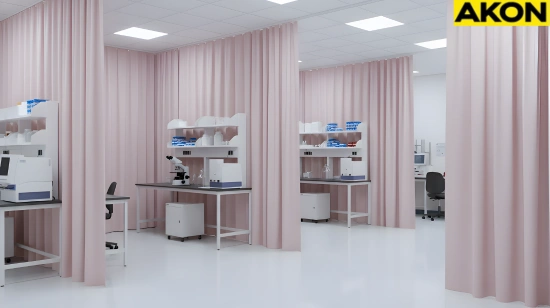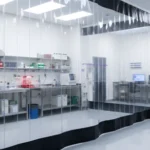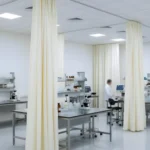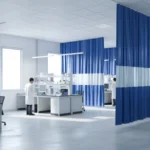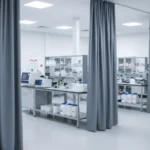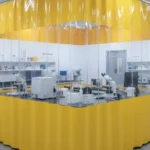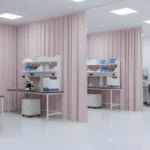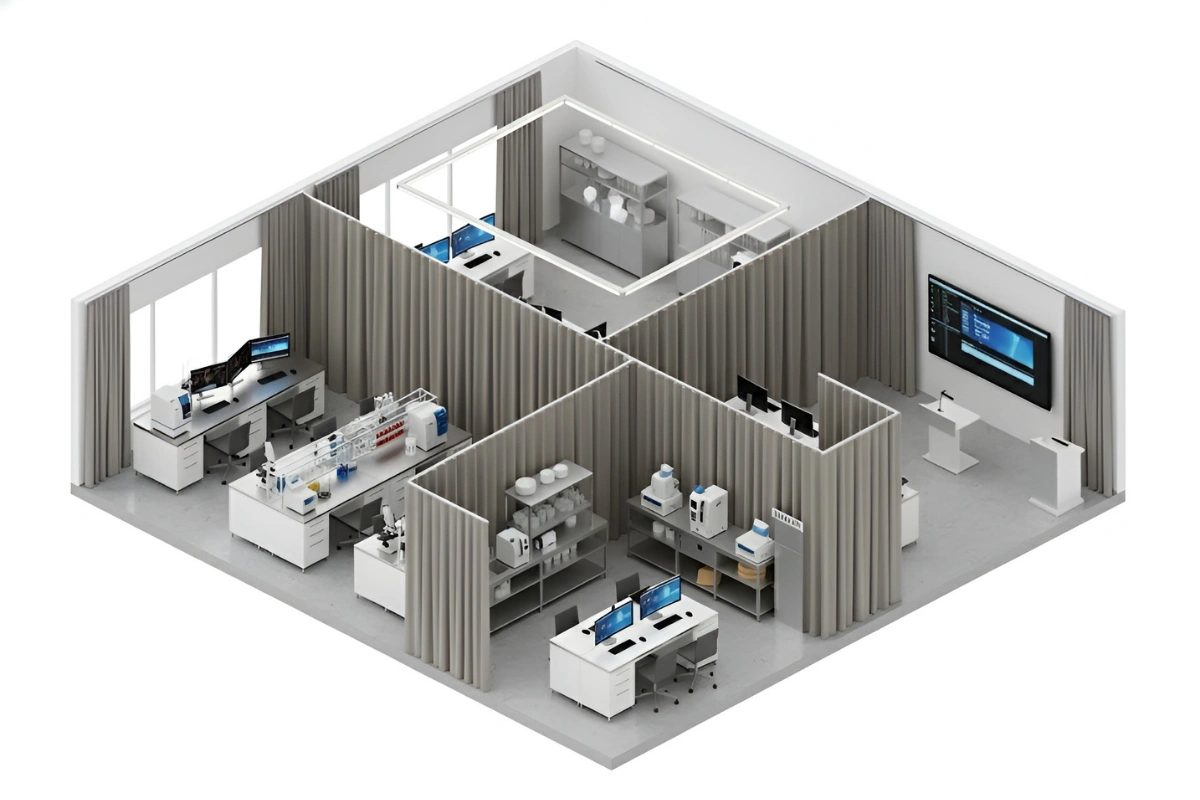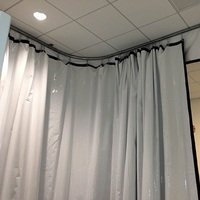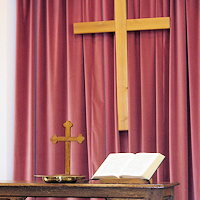Research Lab Curtain Walls
Research labs working with UV-sensitive materials face challenges such as light exposure, contamination, and limited workspace. This article explains how curtain enclosures, also known as a UV isolation curtain lab setup, help maintain controlled, light-free environments. You’ll learn their benefits, main features, real-world uses, and how to choose the right system for your lab.
What Are Curtain Enclosures for UV-Sensitive Material Handling?
Modern research labs need adaptable systems that protect sensitive materials while supporting flexible workflows. Curtain enclosures are designed for that purpose, offering customizable barriers that bring structure and control to lab environments without restricting movement or requiring permanent construction.
Understanding Curtain Enclosures in Research Labs
A curtain enclosure is a modular barrier made from UV-blocking fabrics and cleanroom-safe materials that isolate specific zones for photo-reactive or biological work. These systems help researchers manage factors such as airflow, light, and particle control, keeping UV-sensitive materials secure during preparation, testing, or storage.
They are a cost-effective way to achieve the same precision and safety as enclosed lab rooms while maintaining flexibility for changing experiments.
How Curtain Enclosures Differ from Standard Curtains
Lab-grade curtain enclosures are built for precision. They feature tight seals, smooth-glide track systems, and custom sizing that ensure complete UV protection.
Unlike standard industrial partitions, they can be reconfigured quickly as research layouts change, making them an essential part of a UV isolation curtain lab setup for modern laboratories Their ability to adapt to different lab environments makes them ideal for facilities focused on both innovation and efficiency.
Benefits of Curtain Enclosures in Research Labs
• Quick Installation: These systems can be installed fast, minimizing downtime and allowing researchers to resume experiments quickly. The process requires little to no structural work, keeping daily operations uninterrupted.
• Cost-Effective: Curtain enclosures save money by removing the need for permanent construction and frequent remodeling. Their reusable, modular panels allow for changes without starting from scratch.
• Improved Lab Aesthetics: Beyond functionality, curtain systems enhance the overall appearance of a lab. Their clean, professional design helps create a visually organized space that promotes focus and efficiency.
UV Protection
They keep photo-reactive materials fully shielded from UV exposure, ensuring stable experiments and accurate results.
Contamination Control
They maintain cleaner, contained zones by limiting air movement and particle transfer during sensitive procedures.
Flexibility & Efficiency
They allow quick reconfiguration of lab zones, helping teams adapt layouts without disrupting ongoing work.
Material Options

Vinyl
In areas where getting the curtain dirty is a concern we have the 18oz Vinyl curtains. Its slick surface makes it easy to clean and it is resistant to water spray. Unlike the fabric materials its surface is more reflective and shiny. This is the workhorse material that is made for less than ideal conditions. 100% Visual blackout, 90% Light blackout. $$
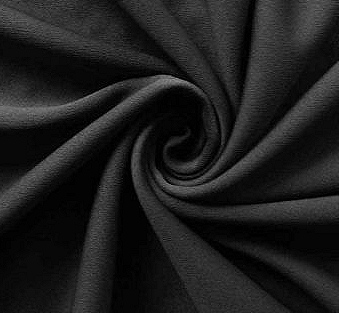
Fabric | Poly Stretch
Poly Stretch 6oz is a soft material commonly used in many commercial and industrial photo applications. It’s a two-way stretch fabric with zero, to minimal wrinkle and it has a flat matte finish. It is commonly used to create backdrop walls for photography of large products like automobiles. 75% Visual blackout, 50% Light blackout. $$

Fabric | Premium Velour
This luxurious 14oz fabric is ideal for stage backdrops, dividing a space or creating a high-end look with fabric. It's inherently flame resistant, lightweight and washable. It's the ideal fabric for commercial curtains that need to look great at a reasonable price. 100% Visual blackout, 90% Light blackout. $$$
Material Options

18 oz Reinforced Vinyl (standard)
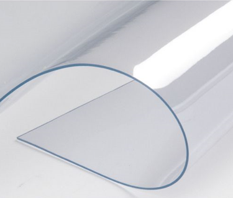
20 mil Clear PVC For Clarity
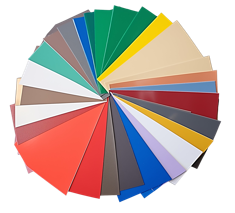
Available in Multiple Colors
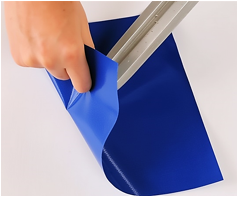
Strong Materials
Key Features and Comparison Table
Curtain enclosures are built with specialized features that make them ideal for handling UV-sensitive materials. Each component plays a role in maintaining control, cleanliness, and efficiency inside the lab. When designing your UV isolation curtain lab setup, consider the following key features to ensure lasting performance and flexibility.
| Feature | Why It Matters | What to Look For |
|---|---|---|
| UV-blocking fabrics | Protects photo-reactive and biological materials from harmful light that can alter results or cause degradation. | Certified UV-attenuating vinyl or PVC materials designed for laboratory environments. |
| Full-perimeter seals | Blocks light leaks and prevents airborne contaminants from entering sensitive zones. | Overlapping panels, edge seals, and floor sweeps for full coverage and consistent sealing. |
| Modular track system | Enables quick layout adjustments without interrupting ongoing research. | Smooth-gliding ceiling or wall-mounted tracks for effortless reconfiguration. |
| Cleanroom-safe materials | Supports hygiene and compliance standards in sterile environments. | Flame-retardant, chemical-resistant finishes that can withstand frequent cleaning. |
| Operational efficiency | Reduces setup time and disruption compared to permanent construction. | Fast installation, low maintenance, and long-lasting performance under daily lab use. |
Choosing enclosures with these features helps ensure strong UV protection, cleaner workspaces, and efficient lab operations for years to come.
Recommended Curtain Systems for Research Labs
Curtain enclosures play a vital role in laboratories that handle UV-sensitive materials. They help improve workflow, protect delicate samples, and maintain controlled environments for precise research. Whether it’s for chemical handling, biological preparation, or material storage, these systems ensure each workspace remains safe, clean, and UV-free.
Insulated Curtain Wall
A durable, high-performance curtain system built for laboratories that need both temperature and UV control. It helps maintain consistency in climate-sensitive zones while improving containment.
• Offers insulation and UV protection in one system.
• Maintains stable environmental conditions for sensitive materials.
• Features tight perimeter seals to prevent leaks and cross-contamination.
• Ideal for long-term laboratory setups requiring durability and precision.
Fabric | Poly Stretch
A flexible, lightweight curtain system ideal for dynamic or shared research areas. It provides reliable UV protection with easy mobility for quick layout adjustments.
• Lightweight material simplifies repositioning and cleaning.
• Maintains UV control without sacrificing ventilation or comfort.
• Enhances daily workflow with smooth-gliding track operation.
• Ideal for labs needing frequent setup changes or multi-zone use.
Fabric | Premium Velour
A premium fabric enclosure that combines superior light control with a professional finish. Its dense weave provides excellent UV absorption, ideal for advanced or presentation-ready research spaces.
• Delivers maximum UV isolation for photo-reactive materials.
• Adds a refined, clean appearance to lab interiors.
• Durable and compatible with cleanroom maintenance routines.
• Reduces glare and supports precision work under controlled lighting.
Frequently Asked Questions
FAQs – Curtain Enclosures for UV Light-Sensitive Material Handling in Research Labs
How does a UV isolation curtain lab setup protect materials from light exposure?
A UV isolation curtain lab setup uses UV-blocking fabrics like Fabric | Poly Stretch to block harmful ultraviolet rays. This helps maintain controlled environments and prevents photo-reactive or biological materials from degrading during research or testing.
Can curtain enclosures fully block UV light in research labs?
Yes. When built with certified UV-attenuating materials such as Fabric | Premium Velour or Insulated Curtain Walls, these systems can block nearly all UV rays, ensuring reliable protection for light-sensitive samples.
What materials are best for UV-sensitive lab applications?
For UV isolation, labs commonly use PVC, vinyl, or velour fabrics treated with UV-blocking compounds. Products like Poly Stretch and Premium Velour offer excellent protection while maintaining flexibility and easy cleaning.
Are curtain enclosures safe for cleanroom or sterile lab environments?
Absolutely. Cleanroom-safe materials used in Insulated Curtain Walls and Premium Velour curtains meet hygiene standards, resist chemicals, and withstand regular cleaning with disinfectants.
How long do curtain systems last in laboratory environments?
With proper maintenance, most high-quality curtains last 10 years or more. Using durable fabrics like Poly Stretch and Premium Velour can extend lifespan and reduce replacement costs.
Do UV-blocking curtain systems help control temperature or humidity?
Yes. The Insulated Curtain Wall line provides both UV protection and thermal control, helping maintain consistent conditions in temperature-sensitive labs.
How easy is it to install curtain enclosures in an existing lab?
Curtain systems are designed for quick installation using ceiling- or wall-mounted tracks. Most labs can integrate solutions like Fabric | Poly Stretch without construction or downtime.
Can I customize the size and layout of my UV curtain enclosure?
Yes. Every setup can be tailored to your workspace, from small prep areas to large testing zones. Custom Insulated Curtain Walls and Fabric | Premium Velour panels can match specific height and sealing requirements.
How do curtain enclosures prevent cross-contamination between zones?
They use overlapping panels, edge seals, and optional floor sweeps to keep each area contained. Systems like Insulated Curtain Walls are ideal for separating clean and process zones in high-precision labs.
What makes curtain enclosures better than permanent partitions?
Unlike fixed walls, modular systems like Fabric | Poly Stretch can be easily reconfigured or moved. This flexibility reduces renovation costs and keeps labs adaptable as research needs evolve.
Do curtain enclosures need special cleaning or maintenance?
No. These systems are easy to maintain, simply clean with standard disinfectants. Both Poly Stretch and Velour fabrics resist chemicals and maintain their appearance over time.
Can UV-blocking curtains integrate with existing lab lighting and airflow systems?
Yes. Curtain enclosures are compatible with most lab HVAC and lighting setups. The design ensures airflow balance and light control without interfering with sensors or ventilation.
Which curtain color or texture offers the best UV protection?
Darker or denser fabrics like Premium Velour block the most UV light. For labs needing a cleaner aesthetic, Poly Stretch offers a smooth, professional finish while maintaining UV resistance.
Can curtain enclosures be expanded or relocated later?
Yes. Modular track systems make it easy to add sections or move panels as your lab grows. Poly Stretch curtains are especially suited for labs that frequently update their layouts.
Are curtain walls compliant with lab safety and fire codes?
Allcurtain products, including Insulated Curtain Walls, meet NFPA fire-retardant standards and comply with laboratory safety requirements.
Can UV isolation curtains be combined with permanent walls?
Definitely. Many labs use Insulated Curtain Walls alongside existing structures to create sub-zones or add extra UV and contamination control where needed.
How effective are curtain systems at controlling airflow?
Curtain enclosures significantly reduce airflow between sections, especially when using sealed Insulated Curtain Walls or floor sweeps. This helps maintain stable pressure and cleaner environments.
Are these curtains resistant to chemicals used in labs?
Yes. Both Premium Velour and Poly Stretch fabrics are chemical-resistant and hold up to frequent exposure to alcohols, solvents, and disinfectants.
How do curtain systems improve workflow in research labs?
By dividing spaces efficiently, curtain systems let researchers run multiple processes simultaneously. Products like Poly Stretch and Insulated Curtain Walls reduce movement disruptions and improve productivity.
How can I request a quote or design recommendation?
You can request a free consultation or quote directly through our website. Our team will help design a UV isolation curtain lab setup using Insulated Curtain Walls, Fabric | Poly Stretch, or Fabric | Premium Velour to meet your specific research needs.
Build a Safer, More Adaptable UV-Controlled Lab
Curtain enclosures provide research labs with an efficient way to manage UV-sensitive materials through reliable light control, contamination prevention, and workspace flexibility. A UV isolation curtain lab setup keeps materials protected while minimizing renovation costs and setup time. Create a safer, more adaptable workspace, contact us today to get a custom-built solution for your laboratory.

